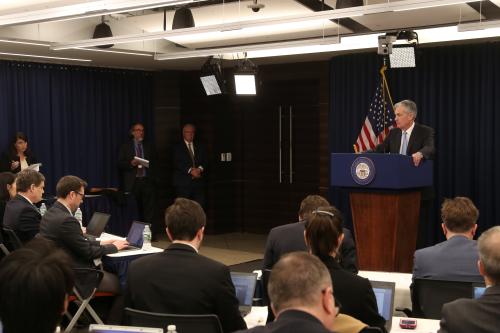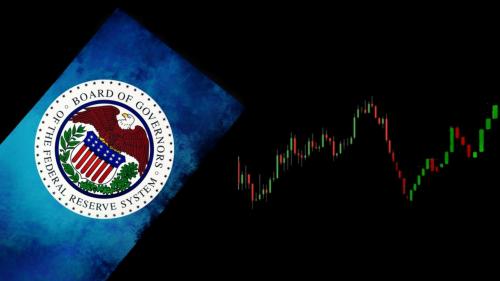This paper is part of the Summer 2020 special edition of the Brookings Papers on Economic Activity, the leading conference series and journal in economics for timely, cutting-edge research about real-world policy issues. The editors are Brookings Nonresident Senior Fellow and Northwestern University Professor of Economics Janice Eberly and Brookings Nonresident Senior Fellow and Harvard University Professor of Economics James Stock. Submit a proposal for future BPEA conferences here.
The Federal Reserve could help insure against long-lasting economic scars from the very sharp COVID-19 recession by creating a credit facility to assist large publicly-traded firms with high debt loads to move efficiently through Chapter 11 bankruptcy, suggests a paper discussed at the Brookings Papers on Economic Activity (BPEA) conference on June 25.
At the same time, the Federal Reserve could liberalize the terms of its Main Street Lending Program to better help smaller owner-managed firms avoid liquidation under Chapter 7 bankruptcy, suggest Markus Brunnermeier of Princeton University and Arvind Krishnamurthy of Stanford University.
In Corporate debt overhang as credit policy, the authors argue the Federal Reserve should design its lending facilities to address the unique challenges posed by the current recession. During the global financial crisis more than a decade ago, the Federal Reserve supported the economy by keeping credit flowing to businesses and households when the broken financial system could not. In the pandemic crisis, the Federal Reserve’s actions in March, including the creation of facilities to support the corporate bond market, effectively restored market functioning much more quickly. Large corporations, if comfortably solvent, can raise cash if they need it. Now, because the current crisis has affected different firms differently, the challenge is to target credit support where it is most needed to insure against economic scars that could linger for years, the authors say.
“2020 is not 2008. Although both the ongoing COVID collapse and the global financial crisis have led to significant economic destruction and hardship, the nature of the collapses differ in fundamental ways,” they write.
In particular, firms with already-high levels of debt, especially risky high-yield debt, are paying much more to borrow than other firms. If Federal Reserve officials expected the economy to bounce back quickly, it might make sense to support these firms. But, since the Federal Reserve is projecting that the economy will need several years to recover its pre-pandemic vigor, it is better to ensure an efficient bankruptcy process rather than subsidize firms to continue at the edge of solvency, the authors argue.
“If you let the firm continue with a high debt load, the firm is eroding along the way … laying off employees, not doing maintenance … directing whatever liquidity it has to maintaining debt service,” Krishnamurthy said in an interview with The Brookings Institution.
Chapter 11 bankruptcy, typically used by large companies in trouble, provides an automatic stay on debt payments, allowing time to negotiate debt reductions. The company’s debt and equity holders take a loss. But, in the meantime, the company continues operating and the underlying source of its value—its real estate, its equipment, its employees—do not disappear.
Krishnamurthy said the bankruptcy system currently is working smoothly even though the number of large-firm bankruptcies is rising toward the level last seen during the global financial crisis. The concern is that a further surge in bankruptcies, especially if the pandemic takes a turn for the worse, could squeeze the supply of the debtor-in-possession financing that provides firms in Chapter 11 with operating capital. Thus, the authors suggest, the Federal Reserve could create a Debtor-in-Possession Facility, with backing from the U.S. Treasury Department, to stand ready to ensure an ample supply of bankruptcy financing.
Additionally, although the banking system is currently in good shape, loan losses produced by rising bankruptcies could weaken banks. Therefore, the Federal Reserve should consider preemptive actions to shore up bank capital, such as barring capital distributions and requiring banks to maintain higher capital levels by triggering its countercyclical buffer, the authors suggest.
Meanwhile, the authors write that small- and medium-sized owner-managed firms need more help to avoid bankruptcy. These firms typically use Chapter 7, which requires that the firm sell its assets to satisfy creditors’ claims. In many cases, the owners of small firms have pledged their personal assets to get loans and must also go through personal bankruptcy when their business fails. Thus, when the pandemic passes and their business can again operate profitably, the owners would not have the personal assets necessary to re-start.
“If the government doesn’t do anything, a significant sector of employment will be destroyed so avoiding bankruptcy in these instances makes the most sense,” Krishnamurthy said.
Congress created the Paycheck Protection Program, administered by the Small Business Administration. It has provided small firms with forgivable loans to meet payroll and other operating expenses for eight weeks. The Federal Reserve in April announced its Main Street Lending Program, which, with Treasury Department backing, will finance loans through commercial banks to small and medium-sized businesses with up to 15,000 employees. Since the announcement, the Federal Reserve has twice expanded and liberalized the program. Currently, the minimum loan size is $500,000, the maximum size of new loans is $35 million, the length of the loans is five years, and repayment can be deferred for two years.
But the authors argue the Federal Reserve could sharpen its efforts to support small- and medium-sized businesses. For instance, it requires that commercial banks have “skin in the game” by retaining 5 percent of the credit risk of the loans. And, it set an interest rate on the loans currently in the range of 3-to-3-1/2 percent (one- or three-month LIBOR plus 3 percent). The authors suggest the Federal Reserve could use the Treasury funds to subsidize the loans by lowering the interest rate on them to zero or below. And it could encourage banks to make more loans by eliminating the requirement that they retain 5 percent of the risk.
David Skidmore authored the summary language for this paper.
CITATION
Brunnermeier, Markus and Arvind Krishnamurthy. 2020. “Corporate Debt Overhang and Credit Policy,” Brookings Papers on Economic Activity, Summer, 447-488.
CONFLICT OF INTEREST DISCLOSURE
The authors did not receive financial support from any firm or person for this paper or from any firm or person with a financial or political interest in this paper. Krishnamurthy is an academic consultant to the Federal Reserve Bank of San Francisco and the European Central Bank, and he is currently not an officer, director, or board member of any organization with an interest in this paper. Brunnermeier sits on advisory boards for Deutsche Bundesbank and Luohan Academy, an open research institute initiated by the Alibaba Group. No outside party had the right to review this paper before circulation. The views expressed in this paper are those of the authors, and do not necessarily reflect those of Princeton University or Stanford University.





